
Features
Emergency & disaster management
Hot topics
A decade of disaster supplement
When we set out months ago to plan this editorial supplement, we consulted our advisory board of 13 fire chiefs and fire-service manufacturers to discuss topics and approaches.
September 20, 2010
By firefighting in canada magazine
Comment:
Lessons from a decade of disaster
By Laura King
When we set out months ago to plan this editorial supplement, we consulted our advisory board of 13 fire chiefs and fire-service manufacturers to discuss topics and approaches.
Seemingly, weather-related incidents and emergencies are becoming more common and being prepared to react to wildfires, floods, hurricanes, monster snowstorms (in October, no less) and tornados is critical for most Canadian departments.
Already this year we’ve run pieces from Surrey, B.C., about a matrix system of response to windstorms (Fire Fighting in Canada, August 2010) and lessons learned from the 2003 and 2009 wildfires in B.C. (FFIC, June 2010).
This Decade of Disaster section looks at the preparations for and co-ordinated responses to some of the most significant weather events of the last 10 years, from the 2000 tornado that shredded the Pine Lake trailer park in Alberta, to Hurricane Juan that devastated parts of Nova Scotia and floods in Manitoba and Peterborough, Ont.
“I think stories could include not only those of actual incidents but those of climate issues and the effect this has on the natural disasters we see now,” said Tom DeSorcy, the chief in Hope, B.C., a member of our editorial advisory board and our Volunteer Vision columnist.
“Also, how the emergency services have learned to work together as a result, such as combined events, communications, etc.”
We’ve tried, in each of our 11 stories, to describe the co-ordinated responses and the lessons learned to help Canadian fire and emergency services plan for future incidents and events. And we found some interesting trends. Cell phones, for example, are often an issue. In Vaughan and Midland, for example, which were struck by tornados within a year of each other, cell phone reception was iffy. In Vaughan, the city used only one carrier and when that provider went offline briefly, communications shut down. Vaughan now has backup phones linked to a second carrier. In Midland, cell reception was sporadic in the aftermath of the tornado that hit on June 23, 2010, and some network providers failed intermittently. A new cell tower has since been installed. These are the kinds of details that departments need to know about in advance of major incidents.
Another common issue is access to emergency operations centres. In some cases, critical players had no way to reach the EOC to find out if they were supposed to report for duty. In another, no one had the entry codes for the EOC. And several communities learned that having permanent computers in the EOC, rather than laptops that may or may not arrive with personnel, along with the correct chargers for laptops and cell phones, is critical.
Bernie Turpin, the administrative deputy chief for Halifax Regional Fire & Emergency Services and a member of our editorial advisory board, knows the drill, having endured Hurricane Juan in 2003 and its winter counterpart, White Juan, in 2004.
“Too often we read stories about disaster but don’t focus on what was learned,” he said. “And even more important, show how those tidbits helped somebody deal with the next event. It might take a bit of research, but would show how important it is to put our successes (and failures) out there for others to learn from.”
Several departments have bared their souls and outlined their successes, challenges and lessons learned in the following pages. We hope you find their testimonies helpful.
Halifax’s Lake Echo/Porters Lake wildfires June 2008
Early evacuations aid firefighters
By James Careless
In June 2008, the Halifax Regional Fire & Emergency (HRF&E) fought two major wildfires at the same time. Both fires started on June 13.
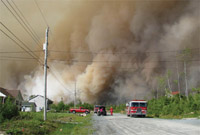 |
|
| More than 5,000 residents were evacuated from homes during the 2008 wildfire near Halifax. |
|
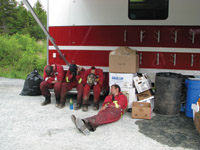
|
|
| HRF&E firefighters rest between shifts during the Lake Echo/Porters Lake wildfires in the spring of 2008. Photos courtesy Halifax Regional Fire & Emergency |
The first wildfire occurred in the heavily wooded communities of Lake Echo and Porters Lake. It destroyed two homes, damaged more than 20 and forced the evacuation of 5,000 residents from 800 homes. This fire covered 6,000 acres and was 15 kilometres long. It burned out of control for two days, fed by 60 kilometre-per-hour winds and forest floor debris left by Hurricane Juan in 2003.
The second fire, which occurred in Tantallon, started later, and forced 32 home evacuations, with no lives lost. It covered 130 acres and was 1.5 kilometres in length.
According to the Nova Scotia government, the Lake Echo/Porters Lake fire “was the largest wildland fire in an urban area fought in Nova Scotia and the largest fire in more than 30 years. It resulted in the most significant fire-caused evacuation in the province’s history.”
“It was a little stressful knowing where all of our resources were at any one time,” said Roy Hollett, an HRF&E deputy chief and the designated site commander for the Lake Echo/Porters Lake fire.
“Yet, thanks to our member departments, we weren’t actually all that stretched. As a result, although the conditions were tough – with our crews having to retreat a number of times due to fast-moving flames – we had what we needed to fight the fires.”
■ Response
- Halifax Regional Fire & Emergency – 158 firefighters.
- Fixed wing/helicopter water bomber support from the Nova Scotia Department of Natural Resources (DNR) and the province of New Brunswick.
- Water tankers were loaned to the regional municipality by Newfoundland and Quebec.
- RCMP.
- Red Cross.
■ Timeline
- The Lake Echo/Porters Lake fire started during the morning of Friday, June 13, 2008, apparently as the result of an out-of-control campfire during dry weather conditions. “It didn’t take long to see the magnitude of the fire as you drove east on Highway 107 out of the city,” said Deputy Chief Hollett. “When you see that much smoke, you know it’s a big one.”
- The fire soon crossed Highway 107. HRF&E and RCMP diverted traffic.
- The Lake Echo/Porters Lake fire was upgraded to EMO-level [Halifax Emergency Measures Office]. “Under that multi-agency plan, I assumed site command; we set up shop right where we were,” said Hollet.
- DNR water-bomber helicopters were on site within a few hours. The fire still grew due to high winds and forest-floor debris.
- The area was evacuated. Evacuation centres were set up in Cole Harbour and at the Seaforth Community Hall, where residents were regularly briefed on the progress in fighting the fire. “We were pushed back down Highway 107 several kilometres at a time; the fire was so fast and intense,” recalls Capt. Cory Dominix of the HRF&E’s Station 21. “Wild rabbits, foxes and raccoons were gathered all around us, just trying to get away from the heat and smoke. It was surreal.”
- The same afternoon, the Tantallon fire started “in brush near three houses on Fir Lane,” says Platoon Chief Paul Hopkins, who ran the Tantallon operation. “We had sustained winds of 30-40 kph with gusts up to 70-90 kph, so the flames just took off from there.” Eventually, 111 firefighters and two DNR helicopters fought this fire.
- On Saturday, both fires raged out of control until the winds died at night. Fire crews finally stopped their progress on Sunday, helped by lighter winds. Residents were allowed to return home
- on Monday.
■ What went well
- Despite size of fire, no lives were lost.
- Early evacuations made a difference.
- Fire crews worked well together; co-ordinated effort brought the situation under control.
■ Challenges
- High winds, extensive dry forest debris.
- Minimal road access, made worse by fires cutting across roads.
- Coincidence of two major wildfires at one.
■ Damage
- Damages were in the millions of dollars due to loss of and damage to homes, land and trees, plus the costs of the evacuations.
■ Lessons learned and actions taken
- Following the fire, which occurred in dry conditions, the HRF&E imposed a complete ban on outdoor burns.
Peterborough flood July 15, 2004
Timing likely prevented tragedy
By James Careless
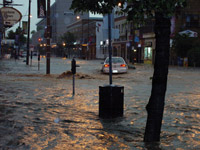 |
|
| Damages to public and private property from the 2004 flood exceeded $100 million. Photos courtesy City of Peterborough Emergency Management Division |
In the early morning of July 15, 2004, the City of Peterborough, Ont., was inundated by a record-breaking 175 millimetres (6.9 inches) of rainfall in two hours. The rainfall overwhelmed the city’s storm water and sanitary sewers, resulting in the declaration of a state of emergency that lasted 15 days.
A roof collapse at the Extendicare Nursing Home required the evacuation of 171 residents through flood waters. Another 25 residents had to be rescued from flooded cars. Hundreds of basements and street level buildings were flooded; roads and embankments were destroyed, leading to considerable property damage; drywall, flooring and furniture were ruined due to mould.
The numbers tell the tale.
1,868 basement pump-outs (including garages, backyards) were completed by firefighters.
1,000 gas disconnections were conducted.
One structure fire occurred at a commercial building on July 15.
498 electrical disconnect calls were made.
Six building evacuations were carried out.
There were 28 medical calls.
28 motor vehicle accidents occurred.
One person was trapped in an elevator;
There were six calls for downed power lines.
■ Response
Peterborough Fire Department
Peterborough Police Department
City of Peterborough (all departments)
28 fire departments from across Ontario, including Toronto Fire Services
Emergency Management Ontario
Otonabee Region Conservation Authority
Ministry of Natural Resources
Ministry of the Environment
Mennonite Disaster Services
Buddhist Monk Organization
Two community colleges, which provided shelter space for evacuees.
Salvation Army
Red Cross
Amateur Radio Emergency Service
Auxiliary Coast Guard Ontario Volunteer Emergency Response Team
Incident commander: Fire Chief Lee Grant, Peterborough Fire Department (now deputy chief, Oakville Fire Department)
On July 15, the Emergency Operations Centre was activated and became fully operational by 5:30 a.m. The Emergency Control group and city staff worked around the clock for the duration of the flood. In many cases staff worked 18 to 20 hour days until the centre closed on July 29 after the state of emergency was lifted. Professional first responders and 503 volunteers worked together to rescue people, shut off power and gas and control the incident scene until the flood waters receded. Shelters were set up at local schools and colleges. The Salvation Army served more than 10,000 meals.
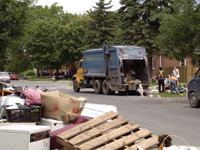 |
|
| Peterborough firefighters pumped out almost 2,000 basements in the aftermath of the 2004 flood. |
■ What went well
“We were very lucky that this only happened in Peterborough, since we were able to get aid from all over central Ontario,” says Grant. “Had the storm also flooded Oshawa or Toronto, we would have been on our own.”
The incident happened when most roads were clear. Had it happened during rush hour, entire streets would have been clogged with flooded cars and the rescue situation would have been much worse. There were no casualties.
■ Challenges
“This happened in a town whose infrastructure is over 100 years old in the downtown core,” says Grant. “Worse yet, no one in North America has ever designed a storm water management system to deal with this amount of rainfall in just two hours. The rapid speed of the flood overwhelmed drivers, roads, sewers and thus limited mobility by emergency services.”
There was a tremendous influx of groundwater into sanitary sewers through pipe leaks and illegal connections.
Many natural drainage channels had filled in without providing alternative overflow routes.
Utility crews had to push their way through the water to pull meters (disconnect power) from flooded homes.
Peterborough simply did not have the facilities or people to manage such a downpour.
■ Damage
Estimated damages to public and private property exceeded $100 million.
Staff overtime and expenses were $1.4 million.
There was considerable damage to homes, furnishings, roadways, retaining walls, landscapes, cars and city infrastructure.
Peterborough’s main library suffered millions of dollars in damage including damage to the Balsillie Collection of Roy Studio Images.
■ Lessons learned and actions taken
Peterborough now has a permanent Emergency Operations Centre and Public Inquiry Centre,” says Jodi DeNoble, certified municipal manager II.
It has also expanded its Emergency Control Group complement to 50-plus staff, and the Public Inquiry Centre has about 80 trained staff. The city has since entered into mutual assistance agreements with the County of Peterborough and its eight lower-tier municipalities, and with Durham Region.
Backup generators have been installed at most city-owned reception centres and there is a program in place to continue with the installation of generators at key service locations in the city.
A comprehensive emergency social services plan and team (60-plus members) has been developed and trained for the delivery of emergency food, clothing, lodging, registration and inquiry, and other personal services
such as counselling, financial aid, first aid, child care, and pet services.
Following the flood, the City completed a flood reduction master plan. Based on the plan, there have been significant upgrades and improvements made to municipal infrastructure under the City’s adopted flood reduction. This is a multi-year, multi-million dollar program that is ongoing to date. Details can be found at: www.peterborough.ca/City_Hall/Chief_Administrative_Officer/Flood_Reduction_Program.htm
Hurricane Juan/White Juan, Halifax 2003/2004
EOC activation proves prudent
By James Careless
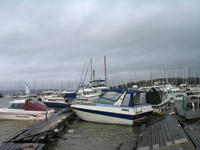 |
|
| The category 2 Hurricane Juan prepared Halifax-area residents for White Juan six months later. Photos courtesy Dartmouth Yacht Club |
|
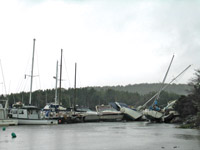 |
Category 2 Hurricane Juan marched through Halifax, N.S., just after midnight on Monday, Sept. 29, 2003. Its impact was extensive: five people dead; more than $100 million in direct damage; one million trees destroyed; and power disrupted to hundreds of thousands of home for days afterwards.
“Hurricane Juan was a 100-year storm, something none of us had ever dealt with before,” says Barry Manuel, emergency management co-ordinator for the Halifax Regional Municipality (HRM). “It was one of the biggest catastrophe to hit Halifax since the 1917 explosion.”
Just six months later, on Feb. 18, 2004, a blizzard that came to be dubbed White Juan, dumped 60 to 90 centimetres (24 to 36 inches) of snow on Nova Scotia and Prince Edward Island. Halifax declared a traffic curfew to keep the roads clear for snow ploughs, but even with this effort, public transit was offline for four days after the storm.
Still, things could have been much worse. The reason they weren’t? In both cases, HRM officials activated the city’s emergency plan before the events, opened up their Emergency Operations Centre in Woodside – in the same building and floor as the provincial and federal emergency ops centres – and made sure everything that could be done was done beforehand.
“We’ve had our emergency plan in place since 1996,” says Manuel. “It saw us through after the Swissair Flight 111 crash of 1998, in which all onboard that MD-11 died. The same plan helped us during 9-11, when we had to house 8,000 stranded airline passengers. It did the job during Hurricane Juan and White Juan, and we are still using it today.”
■ Responding agencies to Hurricane Juan and White Juan
Halifax Regional Fire & Emergency Service
Halifax Regional Police
Halifax Regional Municipality government
Nova Scotia government
Federal government
Incident commander: HRM EMC Barry Manuel
■ What went well
In both instances, emergency officials activated HRM’s EOC before the event.
All municipal fuel tanks (backup power and vehicles) were topped off beforehand.
In the case of Hurricane Juan, extra oil tankers were purchased and parked.
Vehicles and buses were staged across the 5,000 square kilometers of HRM to ensure that road blockages would not hamper response.
Emergency staff were in position before each events, reducing reaction time.
The public was briefed by various media sources before events began.
The closeness of the EOCs and adherence to emergency plan allowed for fast face-to-face meetings, easy inter-agency liaison and clear lines of authority/responsibility.
Hurricane Juan made HRM residents more likely to stock up when warned about White Juan.
■ Challenges
Fallen trees and power lines blocked many roads during Hurricane Juan; snow blocked them during White Juan. This slowed down many emergency responders.
Power was lost in many areas due to storm damage.
Hurricane Juan struck from midnight through the morning of Sept. 29; White Juan raged for 24 hours straight.
■ Lessons learned and actions taken
Beyond making some minor tweaks to the emergency plan, the system worked and is still in use today.
Fort Erie, Ont., snowstorm October 2006
Communication key to better response
By James Careless
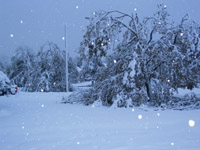 |
|
| Clean-up costs after the early October snowstorm exceeded $2.5 million. Photo courtesy Town of Fort Erie |
October is usually a relatively mild month in Fort Erie, Ont. But on Thursday, Oct. 12, 2006, the town was buried by a freak blizzard that also inundated nearby Buffalo. The winds hit 90 km/h and the snow just kept coming and coming – and coming.
When the blizzard ended the next day, between 30 and 50 cemtimetres of wet, heavy snow had fallen. The weight brought down utility wires and trees, blacking out Fort Erie and area, and littering roads with obstacles.
The storm and its aftermath was a major challenge for local first responders and government. However, to their credit, these agencies worked together not just to survive the storm, but also to analyze the event and find ways to improve their responses the next time.
The following information was compiled by the people who played key roles in Fort Erie’s so-called White October storm including former Fort Erie Fire Chief James Douglas (on duty at the time), present Fire Chief Harry Coplen, Fort Erie Chief Administrative Officer Harry Schlange and Fort Erie Director of Infrastructure Services Ron Tripp.
■ Response
Fire responded to approximately 650 calls in 72 hours (normal annual call volume 1,300)
■ Responding agencies
Fort Erie Fire Department
Niagara Emergency Medical Services (EMS)
Canadian Niagara Power (CNP)
Hydro One
Niagara Regional Police
St. John’s Ambulance and Red Cross (emergency shelters)
Regional Municipality of Niagara Community Services – emergency financial assistance
Local governments, hydro authorities
YMCA – Daycare for school-age children
Community Services line crews, tree crews
Salvation Army, Jaycees
■ Incident commanders
Fort Erie’s Emergency Control Group consisted of:
Fort Erie Mayor Wayne Redekop
Harry Schlange, Chief Administrative Officer
James Douglas, Fire Chief and CEMC?
Ron Tripp, Director of Infrastructure Services
In addition, Margaret Neubauer, Fore Erie’s director of corporate services, was instrumental in obtaining disaster relief funding from the province.
■ Timeline
Thursday, Oct. 12, 2006
1530 – Heavy wet snow begins to fall; rapid accumulation.
1500 – Canadian Niagara Power reports widespread outages: 15,000 in Fort Erie and 3,500 in Port Colborne.
1700 – Volunteer firefighters are directed to man all stations due to snow accumulation and numerous calls.
1700 – Four to six inches of heavy wet snow on the east side of town.
1700-2300 – Fire Department continues to receive heavy volume of calls.
2100-2200 – Power off throughout entire community.
2200 – CNP attempts to re-energize areas resulting in more calls – again heavy volume
2359 – Snow continues to fall. Public works crews clear main travel routes and primaries where accessible; downed trees and wires blocked streets throughout the town.
Friday, Oct. 13, 2006 – Morning
Overnight, heavy wet snow continues. resulting in accumulation of 12-plus inches.
Extensive damage to tree and wires; no hydro through-
out community.
Town snow ploughing efforts are hampered by tree and wire damage.
0900 – Informed by CNP that there is a total black-out; 70-plus line techs are working.
The snow ended overnight; weather changes and gets warmer with sunny breaks.
The main power lines to town are down; there are 70-plus broken poles.
1015 – Updated by CNP – The entire town is out of power and it is anticipated that it will take three to five days to restore. There is extreme damage to entire grid.
Emergency is declared at 1230.
Saturday, Oct. 14, 2006
0700 – All town staff and contractors are deployed to assist in the cleanup.
0800 – EOC is open and manned; switchboard is open.
Flooding with quick melt off becomes a concern.
1030 – Port Colborne terminates its state of emergency.
Evening: There are three house fires, two with significant damage.
2220 – Update from CNP – about 7,000 of 15,500 hydro customers are connected; aiming for 1,000 more overnight.
Sunday, Oct. 15, 2006
0700 – Town crews and contractors are deployed for cleanup.
2155 – The EOC is alerted by the school board that schools will be closed Monday.
Monday, Oct. 16, 2006
0700 – All crews assigned to cleanup are deployed.
Assistance received from other municipalities including the Town of Niagara-on-the-Lake, the City of Niagara Falls and the City of St. Catharines.
0900 – Update from CNP: good overnight progress; up to 11,500 hydro customers reconnected. Schools are closed
1620 – All primary lines are energized.
Mayor terminates state of emergency.
■ What went well
No solos, no egos: everyone worked together.
Mayor took charge, Emergency Control Group did its job.
EMO teleconference – a great way to exchange info with the province; found out about neighbouring towns experiencing similar emergency situations.
Volunteers manned fire stations 24 hours until notified not to, even though there were personal emergencies at home as well.
Infrastructure staff made themselves available for the emergency, again, even though there were personal emergencies at home.
Emergency Control Group analyzed the situation well before declaring a state of emergency. Once the emergency plan was enacted, it worked well.
Director of Infrastructure Services kept EOC well informed of status of roads.
Regional Social Services quickly set up emergency shelters and worked independently with no assistance or additional resources required. Also reached out to list of seniors living on their own to see if assistance was required.
Town staff came in to man emergency phones.
■ Challenges
Operations Department was not prepared; ploughs were not ready for early snow storm.
Contractors not set up until Nov. 1 to be in operation.
Once the storm ended, a massive cleanup of downed trees was required to get roads open.
The quick thaw of the metre of heavy, wet snow caused flooding in flood-prone areas and in many areas that had not previously had problems.
Communication was poor during storm between EOC/town staff and EOC/fire stations.
Radio station contact was poor; stations were not manned overnight and on weekends.
Access to town hall was a problem; keypad not on back up power so would not work.
Minute taker not used during emergency so everyone took their own notes; this did not work well, especially when it got busy
■ Damage
Expenses incurred during and after the event totalled $3,282,764.34.
Emergency relief – $127,285.75
Clean-up costs – $2,554,228.59
Repair/restoration of municipal infrastructure to pre-disaster condition – $601,250.00 Ontario Disaster Relief Municipal Funding (ODRAP) of $1,800,000 was received.
■ Lessons learned
Better co-ordination with utilities, police and Niagara EMS (connect and maintain two-way communications throughout event).
GIS mapping – be able to show what’s up and what’s down.
Connect with Enbridge Gas to co-ordinate efforts and keep informed.
Bell telephone – local contacts needed to be available.
Ham radio operators – identify and use (AREIS).
ECO staff communications “Mike” or “10/4” cell phones or possibly BlackBerrys.
Remember cell networks can jam up during emergencies.
Educating the public on how to be self sufficient for 72 hours.
Ensure cell phone reception at town hall is effective.
Access to town hall – keypad needs to be on back-up power.
Key senior staff need to be provided with master keys for entire town hall complex and Leisureplex.
Enhancements to EOC needed: TV access, radio access, two-way radios, fax access, off-network printer/copier, two or three work stations complete with telephone and computer network access; enhance teleconference capability; set up 1-800 number for town hall; whiteboards. (Note: since the storm, two flat screen TVs and improved communications have been installed.)
Network with public volunteer groups for help contacting seniors and cleaning up seniors’ properties. Know who can help and how to contact them before the emergency.
Make sure a scribe is available for the duration of the emergency so that the EOC is open to record all actions, meeting notes and telephone conversations.
Better clarify the role of Emergency Control Group – who should be on primary list, who are secondary resources, check lists/duties for each role; cross-training for those readily available to get things up and running.
More EOC preparation – dedicated source of funds, have resources available for staff working – cots and blankets, non-perishable food sources; dedicate an area for rest, away from the main action area.
Followup and build on relationships with Red Cross (shelter) and region’s social services personnel.
St. John River flooding April / May 2008
Pre-planning prevented injuries
By Andrew Sanojca
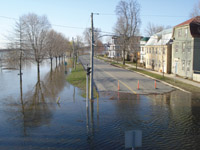 |
|
| Officials realized in January 2008 that there was a potential for serious springtime flooding along the St. John River. Photo by Tony Whelan |
The unincorporated rural areas covered by the Oromocto Fire Department are at risk of flooding each spring as snow melts, but a combination of heavy snow, heavy spring rains and warm temperatures caused the worst flooding in the area in 35 years during April and May 2008.
Serious flooding along the St. John River, which runs from northern New Brunswick near Edmunston to the Bay of Fundy at Saint John, resulted in many agencies working together to keep residents safe.
Andy Morton, the deputy director of the New Brunswick Emergency Measures Organization, summed up the situation at the time. “Early on it was obvious that we had a lot of suspended water in the northern snow pack following a record-setting winter. The only question that we had left was how fast it would melt out and would we get any heavy rain during the melt-out period when the river was already full. Without the rain, water levels would have exceeded flood stage in most areas but not to the same level of severity. Basically, we only realized how bad it would be when we were able to see how much rain fell, especially in the northwestern part of the basin.”
■ Response
Oromocto Fire Department
Fredericton Fire Department
New Maryland Fire Department
New Brunswick Emergency Measures Organization
Royal Canadian Mounted Police (regular members and auxiliary members)
New Brunswick Department of Natural Resources
Canadian Forces Base Gagetown Fire Department (on standby to assist Oromocto duty crew with any fire calls during flooding)
York Sunbury Ground Search & Rescue
Tri-County Ground Search & Rescue
Red Cross
Department of National Defence (CFB Gagetown)
Department of Fisheries and Oceans Canada (provided boats and personnel for rescue)
Approximately 25 surrounding fire departments from as far away as Moncton (175 kilometres east of Oromocto) and Woodstock (100 kilometres northwest)
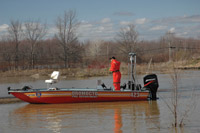 |
||
| The use of the Incident Command System allowed more than 50 departments and agencies to work together, says Oromocto Fire Chief Jody Price. Photo courtesy Oromocto Fire Department |
■ Timeline
In January 2008 it was recognized that there was a potential for serious springtime flooding. The Oromocto Fire Department hired a student who went door to door in the areas that would be affected to issue passes to residents that would allow them access to a cordoned off area to check their properties if an evacuation were ordered.
The owner of an unused vegetable market was approached in January about the possibility of using his building for the command post if needed.
In March, EMO met with fire departments in the area that was likely to be affected.
In early April, firefighters and GSAR surveyed residents and collected information about residents, livestock
and hazards.
In April, the Oromocto Fire Department set up the command post in the Burton vegetable market, a building that had power, could have phone lines installed, and was larger than the mobile command post used in previous years during flooding emergencies.
Flooding began to affect the area on April 23, the same day phone lines were being hooked up at the command post.
Two satellite command posts were established, one at each end of the flooded area.
Fire apparatus and firefighters were staged in areas cut off by flood waters to allow for quicker initial response.
On April 26, three days into the operation, DNR took over planning and logistics, allowing the overall Incident and sector cto focus on operations.
■ What went well
Pre-planning and using lessons learned from previous years’ flooding emergencies helped with the overall management of this incident.
The larger command post allowed all agencies to have room to work under one roof.
Passes issued to residents helped keep non-residents out of the affected area.
DNR planners provided daily action plans outlining priorities for the day. These were distributed to the divisional supervisors in the field at daily briefing/safety meetings.
■ Challenges
Flood waters were unpredictable and covered a large area, which needed to be assessed daily for changing hazards.
Residents who did not heed requests to evacuate early, put rescuers at risk when they finally needed to leave their homes.
Consumables, such as hand sanitizer and medical gloves, needed to be purchased in large quantities to ensure that they were readily available when needed.
■ Lessons learned
The use of the Incident Command System allowed more than 50 departments and agencies to work together. “Provincial DNR staff proved to be invaluable with their knowledge of ICS and large and long-term incidents,” said Oromocto Fire Chief Jody Price.
Issuing passes to residents, while a valuable resource, was time consuming. A system will be developed that allows multiple agencies to issue the passes, with the information stored in a data base that can be accessed by all agencies.
Boats from different agencies and fire departments had only adult-sized personal flotation devices on board. Dozens of PFDs were purchased in various sizes to ensure the safety of residents being evacuated.
Satellite command posts allowed sector commanders to assess their respective areas for changing conditions.
Meals were ordered a week in advance from area restaurants so staff had time to prepare them.
Daily briefings included safety talks – this action is credited with preventing injuries, as just two people involved in the 21-day incident suffered minor injuries.
Manitoba Interlake flood March 2009
Perfect storm stretches resources
By Jay Shaw
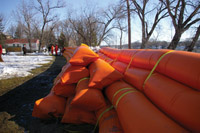 |
|
| On Easter morning a large ice jam broke apart, releasing a six-to-eight-foot wall of water. Photos courtesy Manitoba Emergency Operations Centre |
On Easter morning, April 13, 2009, at about 6 a.m., an ice jam in the Interlake region of Manitoba broke apart, releasing a wall of water that was estimated at six to eight feet high.
The 2009 flood in the Interlake region of Manitoba (the Red River, north of Winnipeg) was not as severe as the so-called flood of the century in 1997 that caused $500 million in damages, but a perfect storm of weather phenomena and unforeseen events made it among the most dangerous incidents on record.
While the 1997 flood primarily affected areas south of Winnipeg, the 2009 calamity stretched resources to the breaking point and caused $40 million in damage.
■ March 23
After a colder than normal winter, combined with record ground saturations, the spring thaw started and the water had nowhere to go. Frigid night temperatures combined with daytime melting backed up water in frozen ditches as volunteer firefighters from the Regional Municipality of West St. Paul and St. Andrew’s worked tirelessly to protect homes from flooding.
Municipal Emergency Co-ordinator Paul Guyader explains why the water collected and started the first of three critical events: “A heavy rainfall in February had covered the ground with an ice blanket that was like a vapor barrier keeping the frost in the ground and not allowing moisture to penetrate.” Water backed up and homeowners reported basement flooding, as emergency operations centres opened proactively and prepared for overland flooding. Unforeseen events that would put the community and responders in danger were days away.
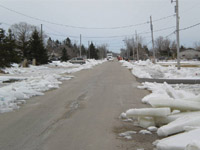 |
|
| Following a colder than normal winter in Manitoba, combined with record ground saturations, the spring thaw started and the water had nowhere to go.
|
■ March 25
The cold winter had made the river ice very thick, as much as 48 inches in some areas. As the ice started to break up, a jam of thick ice formed and river levels rose quickly as water backed up behind a slow-moving wall of ice. (The Red River runs from south to north and drains into Lake Winnipeg. The major incidents are from a westerly perspective along the Red River, with mirror-like incidents happening on the east side.)
Water rescue teams evacuated occupants from three homes in dangerous ice conditions. The water was coming from both directions, as dikes protecting homes from the river also held the spring run off from reaching the river. For the next two weeks, there was a pattern of ice jams backing up and creating extremely fast-rising flood waters, creating the need for pumping, sandbagging and diking 24/7, which exhausted crews and depleted resources. Fire departments from both sides of the river worked above and beyond for weeks to protect property and lives. Jim Stinson the emergency co-ordinator for the Regional Municipality of St. Clements, was just as busy on the other side of the river. “All agencies worked together and collaboratively responded,” he said. “The flood was not surprising, it was the ice jamming that caused such a risky environment for responders, volunteers and residents.”
■ April 13
On Easter morning at about 6 a.m., a large ice jam broke apart, releasing a wall of water that was estimated at six to eight feet high. Guyader explains: “The water and ice was like a tsunami travelling down the river until it hit the pack ice at the south end of the Breezy Point development ( a housing development on the west side of the Red River). It then was blown sideways, destroying houses and travelling miles inland.” This launched a six-fire-department water rescue mission that was extremely dangerous, in freezing temperatures and high winds. Multiple occupants were rescued from homes in the affected areas. Forty to 50 houses sustained damage in this one area alone, with many so severe they were later torn down. Provincial buy-out programs assisted residents with relocation.
■ Responding agencies
West St. Paul Fire Department and public works
St. Andrew Fire Department and public works
Winnipeg Beach Fire Department
Narol Fire Department
Gimli Fire Department
Selkirk Fire Department
East Selkirk Fire Department
East Beaches Fire Department
Manitoba Emergency Medical Services (ambulance)
Emergency Measures Organizations
One thousand volunteers from many communities social groups and clubs
■ Lessons learned
One operation manager for each EOC (Paul Guyader ran both EOCs during the flood and found this to be difficult for communications).
More work is needed to understand ice conditions and strategies for mitigation are needed to reduce damages and risks associated with ice jams.
Group likewise resources into task forces and teams for better structure.
Proactively search out technical resources before you need them (i.e., engineers).
Ensure the availability of plenty of laptop computers with mapping software and municipal plans and data.
Install extra phone lines and implement plans for emergency communications, such as cell phones.
Balancing resources is key as lengthy operations burn out staff and leave departments/agencies vulnerable. If another major event had occurred at the same time, there would not have been enough available resources.
Paul Guyader is now the operations manager for the Manitoba Emergency Measures Organization. He knows that previous table-top scenarios and proactive collaborative actions, such as early recognition that the EOC should be made operational, was crucial in staying a half step ahead of the 2009 situation. No major injuries were reported as hundreds were saved and evacuated in treacherous conditions.
“Probably our biggest area of concern in the post-incident analysis was safety. In our entire operation, including managing up to 1,000 volunteers a day doing manual labor and performing multiple water rescues at night in ice conditions, we did not have a single serious injury. This is probably more due to luck than good management.
West Kelowna Complex July 2009
Unified command simplifies task
By Lou Wilde
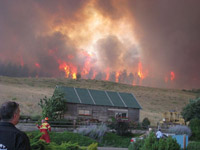 |
|
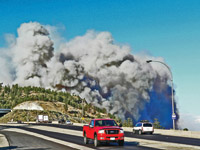 |
|
| The Glenrosa fire, the Rose Valley fire and the Terrace Mountain Fire made up the West Kelowna Complex in the long, hot summer of 2009. Courtesy west Kelowna fire and rescue |
The West Kelowna Complex occurred in July 2009 and comprised the Glenrosa fire, the Rose Valley fire (both suburbs of West Kelowna, British Columbia) and the Terrace Mountain Fire.
The Terrace fire had been burning in a remote area 25 kilometres northwest of the community, when at 2:40 p.m. on July 18, a wild fire was reported on the south flank of West Kelowna. Due to the extreme dry and windy conditions, homes were threatened within 15 minutes of the first report.
Mutual aid from local fire departments and the BC Forest Service was called for immediately as conditions were compounding by the minute.
Tactical evacuations were preformed by the RCMP and West Kelowna Fire and Rescue. With one main road into the Glenrosa subdivision, many residents were evacuating with fire literally on their heels. Fire crews had a difficult time responding with bumper-to-bumper traffic fleeing the neighbourhood.
A formal unified command with WKFR, BC Forest Service and the RCMP had been established within the first two hours of the event along with a level 3 activation of the Regional Emergency Operations Centre for support.
Hours after the Glenrosa fire started, a second wildland event was reported in the Rose Valley area of West Kelowna. This fire was in very steep terrain, was deluged by helicopters and was controlled in a few hours.
The Glenrosa interface fire taxed resources and was the greatest threat to residences.
As Fire Chief Wayne Schnitzler stated, the most significant challenges were:
The importance of having a full view of the incident. “We, as incident commanders, are used to having a 360-degree size up of the situation to create our action plans and strategy. In an incident of this magnitude, you have to be set up far enough to get a complete understanding of what is in front of you, otherwise you miss things or get tunnel vision on portions of the event. If at all possible, there is nothing like an overview from the air. When the incident can not be viewed completely, communications from division supervisors are essential. Continuous updates on progress or the changing conditions must be relayed to the command post when the commander can’t see for themselves.”
The establishment of a unified command with all involved agencies facilitated the co-ordination of limited resources. “Having command level members with contact to their people in the field expedited communications and ensured all requests for resources to command were prioritized and fulfilled. In long duration events that will span multiple operational periods, you will need relief. It is important to recognize this early in the event so that your relief has time to prepare by resting or sleeping prior to their shift starting rather than using them on the fire line.”
As an incident commander, your incident action plan and strategy must be able to flex with variables thrown at you. “In the case of the Glenrosa fire, wind conditions constantly changed forcing the command staff and members in the field to adapt to the changing conditions. The incident commander should always try to scale back operations during night time hours if possible. The dynamic of working in the dark with no power makes the incident more dangerous. If you can, leave minimal numbers of responders to monitor the situation and allow crews to rest for full action at first light.
Accountability of all responders is a must in any event and we’d like to believe that all fire departments practise a method of personnel accountability. “When you have significant numbers of responders from a variety of agencies, you need someone dedicated to maintain a status board of individuals, teams, divisions, groups and branches. You will also need a method that works for all agencies to document who is where and the tasks assigned.”
Utilize the Emergency Operations Centre for your locale. “In incidents of this size, the dispatch centre will soon be overwhelmed with the incident commander’s requests for resources. The command at the incident will require the services from a planning section to process paperwork to declare a local state of emergency. Command will definitely require the services of a finance and administration section to document procurement and payroll (do not underestimate this need!).
“In large-scale events, it is worth while to have an EOC liaison right at the command post to relay messages (to and from) on behalf of the unified command team at the incident. The EOC should also have more than one method of contacting the EOC (cell phone is likely the primary means but a VHF radio as back up is great too).
Vaughan tornado Aug. 20, 2009
Weather warning system overhauled
By Laura King
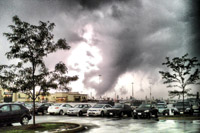 |
|
| Vaughan Fire and Rescue Service received 74 requests for assistance in the first hour after the tornado. Photo courtesy Vaughan Fire and Rescue Service |
Aug. 20, 2009, was a day like most others for the City of Vaughan, Ont., north of Toronto – until 6:15 p.m. The sky was ominous with thunderstorms predicted as workers at the city’s operations centre left after their day shifts.
About an hour later, a tornado bounced through the city, touching down four times and wreaking havoc. A tornado that afternoon in Durham, Ont., killed a young boy but there had been no weather warnings about tornados for the City of Vaughan.
Within half an hour, Vaughan’s Emergency Operations Centre had been activated, most fire officers were either on the scene of one of the four affected areas or in the EOC, and staff in the communications centre had been beefed up.
Lots of things went well, says Emergency Planning Manager Sharon Walker. The tornado hit at supper time in a predominantly Italian community where many homes have basement kitchens, so there were few injuries. Neighbours rallied to provide food and shelter to those whose homes were no longer livable. And although there were some glitches– cell phones died, radio signals were lost – responding agencies worked well together.
Perhaps the most significant change as a result of the tornado is Environment Canada’s plan to revamp its weather warning system, says Walker. In the interim, Environment Canada has set up Vaughan on an effective and efficient text-message warning system.
■ Timeline, Aug. 20, 2009
0330 – Environment Canada issues a general weather statement that the incoming weather system has thunderstorm potential in Ontario.
1015 – Warm, humid conditions in southwestern Ontario.
1615 – Confirmed F2 tornado touchdown in Durham, Ont
1715 – Thunderstorm in Vaughan.
1815 – Confirmed F2 tornado touchdown. Senior command officers / manager of emergency planning notified and requested to report for duty; command officers dispersed to four disaster sites, fire communications centre and EOC. Unified command established at site No. 1 – Andrew Park; one chief officer at Houston Road site; one chief officer at Maple site.
1845 p.m. – Vaughan Fire and Rescue Service senior command activates EOC; the destruction from the tornado and storm system is assessed while the storm continues to move eastward.
1903 – hydro incidents on Teston Road.
1853 – Emergency management team notification started.
2000 – EOC populated.
2030 – First business cycle meeting at EOC.
2138 – City of Vaughan declares state of emergency. More than 7,000 homes are without power.
VFRS received 74 requests for assistance in the first hour of this emergency.
■ Response
Vaughan Fire and Rescue.
Mutual aid – King Fire and Emergency Services, Richmond Hill Fire Department, Markham Fire and Emergency Services (one engine each).
York Regional Police – Maintained security until Aug. 23 when homes were secured and streets were safe; provided investigation services as required and mobile command post; officers were a big influence at the EOC.
York EMS.
PowerStream (hydro) – Brought in outside contractors and had power restored by Aug. 21.
Enbridge (gas) – Locked and tagged affected metres.
Public Works – Cleaned debris off streets; special daily garbage pick up in affected areas; cleared sewer drains.
Parks and Forestry Operations– Supported two community evacuation centres and removed about 1,200 damaged trees with assistance from MNR, Markham, Richmond Hill, York Region and Toronto Region conservation authority.
Building and Facilities and Building Standards – Inspected hundreds of buildings.
Red Cross and Salvation Army.
Two emergency shelters are opened but left largely empty due to community welcoming in evacuees.
Insurance Bureau of Canada set up info booths at community centre to help residents with insurance issues.
■ Damage
600 homes damaged – 38 severely – and one school.
One fatality Durham, none in Vaughan and only minor injuries.
1,200 trees destroyed.
Two parks heavily damaged.
7,000 homes without power (initially 43,000 but bulk was quickly restored)
About 120 homes initially evacuated due to structural damage, gas leaks and downed power lines.
Four major areas of damage:
Andrew Park
Houston Road
Gamble Street
Burnhaven Avenue
■ Communications
Always minimum two operators on duty.
Night shift arrived at 1900 hrs along with a training officer and firefighter trained as communications operators, an off-duty communications operator and an off-duty platoon chief/deputy fire chief.
UPS failure.
Communications centre becomes default interim EOC and requires a chief officer quickly.
Radio issues:
800 Mhz system shared with York Regional Police – around 1715 radio system maxed out for a short period;
At 1801 lightning strike at Egypt tower put system in “failsoft” for 32 seconds but it took five minutes to reset the consoles;
Radio back at 1807; tornado at 1811.
■ Lessons learned
Distribute phone number of EOC to those who need them.
Do not equip mobile command unit with a toilet/bathroom.
Heavily staff the EOC for each position – minimum of two persons.
Telecommunications failure – need more than one carrier.
Weather warning systems needs to be improved.
Building inspectors need to remain on site to answer questions.
Limit sight seers in the impact zones.
Don’t assume people will go to shelters.
Use scribes in all EOC meetings.
Need permanent computers in EOC.
Establish card swipe access to storage room in EOC.
Need universal chargers for cells and computer cords laptops
York EMS (Ambulance service issued a so-called ALL STOP, during which there was no response to calls. Vaughan Fire and Rescue was not notified. This lasted for 60 minutes.)
Okanagan Park fire Aug. 16, 2003
Managing staff a major challenge
By Lou Wilde
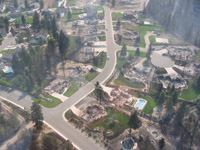 |
|
| Almost 240 homes were lost within the City of Kelowna over 48 hours. Photos courtesy Kelowna Fire Department |
At about 2 a.m. on Aug. 16, 2003, Kelowna Fire Dispatch received a 911 call reporting a lighting strike in Okanagan Mountain Provincial Park on the southern border of the city.
Over the next 25 days, more than 350 structural firefighters from throughout B.C. and Alberta would battle the largest wildland/urban interface fire in Canadian history, alongside 1,400 armed forces members and 1,000 forestry personnel.
A total of 63 municipal fire departments brought more than 75 pieces of apparatus to supplement KFD resources – this doesn’t include the countless number of private contractors hired by the B.C. Fire Commissioner’s Office. Kelowna Fire Department paid and volunteer staff logged more than 10,000 hours above their regular working hours, with some individuals recording more than 275 hours of extra time.
Almost 240 private residences were lost within the City of Kelowna over a 48-hour period – about one house every 12 minutes during the peak of this disaster.
Throughout this ordeal, the Kelowna Fire Department and its members experienced a number of personal and collective triumphs and disappointments. Our department and community had been put through the ultimate test and we learned a great deal about what we’re made of.
In the Emergency Operations Center, hundreds of municipal regional and private-sector employees staffed the ICS sections for more than 50 operational periods, supporting the incident with planning, operations, logistics and finance.
In the end, the wildfire burned 250 square kilometres of provincial and regional forest.
■ Challenges
Managing an additional 350 staff (KFD had 88 career and 60 paid on-call members).
Our (two) staging managers at the base camp used a forestry T-card system to account for members and units.
Briefing huge volumes of people was difficult so we had to have printed incident action plans for company officers to brief their people for each operational period.
With people working long, hard hours, we started to run members through rehab for vitals prior to shift changes to ensure they were ready for work.
Day and night shifts were created for the fire just to cut the numbers in half and to support operations around the clock. Apparatus ran 24 hours a day, so buses were used to take people from the base camp out to the field to a staging area.
Four mechanics worked long hours to keep units on the road.
Fuel depots had to be established close to the fire for quicker turnaround times.
Food, snacks and water delivery to the field was a gigantic task and took a team of people to organize and deliver three to four times daily.
Out-of-town crews were unfamiliar with the rural neighbourhoods they were protecting.
One paid on-call member was assigned to each out-of-town apparatus as an escort who was familiar with the area. In this type of event, you must have local knowledge on each unit.
Many structural firefighters are not prepared for this type of fire.
Some firefighters came expecting to fight house fires, which wasn’t the case. Our members wore coveralls and hard hats and addressed small fires that threatened houses. They had to assess situations and cut their losses. At times, they would come upon a fully involved house that was threatening a second home and they would set up to protect the third, knowing that the second one could not be saved. That was difficult for structural people to accept.
Units had to perform tactical retreats when the fire front came through, then return to mop up hot spots. Large supply lines could not be deployed for master streams. Crews had to back in, do what they could with small manoeuvrable attack lines so they could “bug out” in an instance. It was ideal for engine companies to have a “big line” of 200 feet of one-to-1.5-inch line and about 400 feet of one-inch forestry hose for quick hit-and-run tactics.
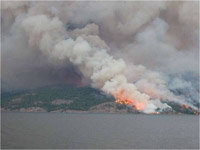 |
|
| The Okanagan Park wildfire of 2003 burned 250 square kilometres of provincial and regional forest.
|
■ Radio communication
Out-of-town apparatus had to have local radio frequencies installed when they arrived. The wildland interface area that our members attended covered about 47 to 52 square kilometres with three branches that included between five and seven task forces each. There were far too many people who had ability to talk on common channels, so we had to limit radio communication to task force leaders and branch directors only. FRS radios were used extensively for crew communications.
■ The aftermath
Almost 30,000 people were evacuated from their homes. Some had animals that had to be left behind or be sent elsewhere while the evacuation order was in effect.
At least 238 families lost their homes. Some never returned, rather sold the properties. There was much work to be completed before any residents were able to return. Property assessments had to be done for risk and taped off so people wouldn’t enter. Police allowed only neighbourhood residents in with photo ID since there were thousands who wanted to see things first hand. It was very emotional for many people to come home and that privacy was respected in most cases.
Police worked very hard to keep people out of evacuated areas. Fire crews were quick to inform police of looters.
Our municipal and regional parks and utility divisions were swamped after the incident, making danger tree assessments and doing flood prevention, since much or all of the vegetation was gone from many drainages. There was great concern that when the fall rains came our next disaster would be landslides and flooding. We were fortunate that there were no significant events.
■ Lessons learned
Staging for large numbers of responders from multiple agencies: most fire departments operate under a common incident command system but when you don’t know people or their accountability systems, you need to be prepared with the proper tools. At the very least, you need a T- card system; ideally, a portable staging kit that you can use in your station or in the field.
Unified command is imperative when incidents involve multiple agencies in order to make the best use of limited resources.
Use the standard ICS forms. From incident action plans to resource request forms, it is important to complete paperwork rather than going by memory so that things are documented. Days drift into one another during prolonged events. People in the field may not have the forms but when the calls come in to your dispatch or emergency operations centre, have someone complete the forms on their behalf. Company officers/ team leaders should keep a notepad in their pocket to document their activities.
When you request help from outside your local authority or mutual aid departments, through your fire commissioners office or other means, be sure that you are clear on what you need, who is coming and what you get. Don’t tell them to send everything they’ve got, because they will. Ask specifically for type 1 engines or type 4-5 engines, type 1 or 2 tenders. We had a guy with a 200-gallon septic truck that wanted to haul water for us (ahhh . . . No!).
These types of events involve a variety of agencies (municipal, regional, provincial and maybe federal resources) and cost lots of money. When requests come in to your emergency operations centre logistic section, be sure to get a name and agency that is making the request and time stamp the request.
If you have large numbers of responders and supplies, you will need a base camp that will not be threatened by the incident and you will need a quartermaster(s) 24 hours a day. Supplies will arrive around the clock and need to be controlled. You can’t allow a first-come, first-served mentality.
Send your local responders home for rest and make them stay there to see their families. I learned this after 25 19-hour days in a row.
Like most fire departments, we had our share of big commercial fires lasting hours (days including mop-up) and our Emergency Operations Centre had been tested with yearly tabletop scenarios and some flooding incidents, but neither had been tested to this extent. In the past seven or eight years we have had five significant interface events and it is very encouraging to see how we are able to operate with the many staff throughout our department and our municipalities that have gained a lot of disaster management experience.
Lou Wilde is the assistant chief in Kelowna, B.C.
Midland tornado June 23, 2010
Disaster exercises prove effective
By Kevin Foster
Just hours after a minor earthquake shook some homes and businesses in parts of Ontario and Quebec on June 23, a tornado blew through the picturesque town of Midland, Ont., with no warning.
Environment Canada issued a severe thunderstorm warning for Midland, which is on the southern shore of Georgian Bay about 150 kilometres north of Toronto, but not until after the tornado struck at about 6:20 p.m. The hardest hit area was Smith’s Trailer Park and Camp, where the twister flipped mobile homes and seasonal trailers.
Environment Canada confirmed that the tornado was an F2, 25 kilometres in length, 300 metres wide and touched down in Midland at more than 60 identified points.
Mayor James Downer declared a state of emergency in the town of about 16,300 but said consistent emergency drills helped residents and emergency responders handle the emergency efficiently.
Fire Chief Kevin Foster said the co-ordinated response was a direct result of two things: the initial first responders who managed the incident; and regular emergency management exercises, training and meetings.
“That made us a fairly cohesive group,” Foster said. “We have been working together on a regular basis and nothing was foreign to us.”
■ Responding agencies
Midland Fire Department with mutual aid from Penetanguishene, Tay, Tiny and County Fire co-ordinators.
Midland Police Service with assistance from Barrie, South Simcoe and the Ontario Provincial Police.
Simcoe County Paramedic Services with assistance from others deployed as part of the G8.
Midland Public Works.
Midland Power Utility Corporation with assistance from Tay, Wasaga Beach, Clearview, Newmarket and others.
Hydro One, Enbridge Gas
Salvation Army, Canadian Red Cross, Catholic Family Life Services
County of Simcoe
Georgian Bay Volunteer Search and Rescue
■ Damage
Estimated at $15 million.
Three mobile homes destroyed at Smith’s Trailer Park and Camp; 10 determined unsafe; another 42 required structural review; 30 seasonal trailers destroyed and 40 damaged.
One residence condemned; five seriously damaged.
Three industrial/commercial buildings destroyed and 18 damaged
Power lost to 9,000 homes/businesses.
Gas supply cut to 12 properties plus 57 units at trailer park.
Significant number of matures trees damaged.
Power distribution lines and poles severely damaged.
■ What went well
Initial arriving emergency responders made swift, effective assessments, were able to direct the immediately available resources and requested the mobilization of
additional resources.
Few injuries and most were minor.
An initial evacuation centre established.
Several Community Control Group (CCG) members recognized the severity of the situation and assembled at the EOC before receiving notification to do so.
Power was restored to most areas within 24 hours.
Roads were kept closed to provide for maximum safety and freedom of movement for work crews.
Regular media communications from EOC to public.
Access to engineering and building inspection resources.
■ Challenges
Cell phone network was sporadic.
Communications centre was quickly overwhelmed with calls.
Blocked roadways – two of the three primary north/south transportation routes into town were blocked with downed power lines and/or trees.
Communications centre had difficulty contacting CCG.
Fuel provider for municipal vehicles (including fire apparatus) lacked power for 24 hours and pumps suffered damage. A pre-determined contingency plan was enacted to maintain fleet refueling for all municipal vehicles.
Public not observing “park closed” signage.
Expectations of seasonal property/trailer owners for lodging when attending to investigate the damage.
■ Lessons learned
Personal preparedness is extremely important.
Improved method of contacting CCG members and other stakeholders is needed. The Town is investigating a software-based mass emergency notification system.
Additional telephone required lines in EOC.
Cellular telephone systems are not a reliable option.
Additional support staff required for EOC members.
Roles in EOC require additional depth, to a minimum of three persons, to provide relief for prolonged operations.
Be clear about reporting locations with staff and volunteers.
Maintain security for EOC building.
Pine Lake tornado Aug. 27, 2000
Military assistance made a difference
By James Careless
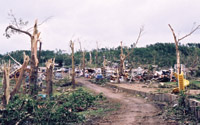 |
|
| Property damage exceeded $15 million after a tornado blew through Pine Lake, Alta., in 2000. Photo courtesy Red Deer County Emergency Management |
Twelve people were killed and 140 injured when an F3 tornado carved its way through the Green Acres Campground at Pine Lake, Alta., on July 14, 2000. The tornado hit about 7 p.m., having touched down 10 kilometres west of Pine Lake and destroyed farmland. The Green Acres Campground was on the west side of Pine Lake, in a hollow. There were about 430 trailers and 900 people on site at the time.
After levelling the trailer park, the tornado crossed the lake, then continued for 10 kilometres before lifting. Winds hit 300 kilometres per hour at the tornado’s centre, with most of the destruction happening within a 500-metre radius of the eye. The total tornado footprint was estimated at 2.4 kilometres.
“The site looked like a landfill, not a campground,” says Capt. David Harvey of the Red Deer County Fire Department. He was the emergency site manager. “Not a single tree was left standing.” Thirty trailers were blown off their sites and into the lake, raising fears that victims had drowned while trapped inside.
■ Response
Red Deer County Fire Department
Delburne Fire Services
Lacombe Fire Department
RCMP
Canadian Red Cross
Central Alberta Amateur Radio Emergency Services radio network
Calgary EMS along with Calgary Fire dive team and Heavy Urban Search & Rescue team
Mutual-aid resources were requested and provided by the City of Red Deer, the Town of Sylvan Lake, Elnora, Spruce View, the Town of Innisfail, the Town of Bowden and the nearby Nova Chemical plant.
Six Canadian navy divers.
Nova Chemicals provided a decontamination team for the divers.
Premier Ralph Klein and Canadian Alliance party leader Stockwell Day arrived that night, which helped with declarations required.
“Many agencies came without being required to, out of the goodness of their hearts,” says Capt. Harvey.
■ Timeline (after the tornado hit)
After 7 p.m., numerous calls were received at the 911 communications centre in Red Deer, reporting that a tornado had struck the Green Acres Campground at Pine Lake.
Calls were then forwarded to Delburne Fire Services.
Delburne immediately contacted Red Deer for mutual aid.
Red Deer County Fire Station 1 served as the EOC.
Large tents were erected to create an onsite command post at Green Acres.
The overall scene commander was Cliff Fuller, acting fire chief of the Red Deer County Fire Department.
Twenty search-and-rescue teams checked trailers and mobile homes on site for injured victims and recovered fatalities.
One hundred soldiers helped.
A second command post was set up on the east side of Pine Lake on July 17. This was for volunteers helping farmers clean up their damaged land.
■ Medical aid
The County Emergency Operations Centre alerted the Red Deer Regional Hospital and a mass casualty response plan was activated.
A triage area was set up by the first paramedics on scene. They began to assess and tag patients for treatment and transport to hospital.
Red Deer Emergency Services provided ambulances and a heavy rescue unit.
Alberta Shock Trauma Air Rescue units (STARS) in Edmonton and Calgary flew to the scene to provide air ambulance service.
About 30 patients sent to Edmonton and Calgary for treatment.
■ What went well
According to Capt. Harvey, local agencies responded quickly to the scene and worked well together.
Air ambulance support provided quick transportation to the most seriously injured victims.
The mass casualty response plan dealt effectively with the influx of patients.
“The military was a great help,” said Capt. Harvey. “They came in with their own resources and knew what to do.”
■ Challenges
The tornado made roads inside the trailer park almost impassable. Emergency crews had to be staged outside the park and then head in on foot. Victims initially had to be carried out by hand. Eventually, golf carts were brought in from a local course and used on the site.
Radio communications were seriously compromised by the area’s low terrain, which kept signals from getting in and out. The line of sight for VHF and UHF radio signals to Red Deer and the campsite is blocked by a tall hill previously used by NORAD as a radar station, due to its height.
“There was no mutual aid radio system in place,” Capt. Harvey notes.
Telephone communications were lost due to the tornado. Cell towers were overloaded due to too much traffic. The local telephone company laid new lines to the onsite command centre on July 15.
So many tires were flattened due to falling debris that a local tire shop was brought in to do repairs and replacements on site.
News helicopters and private pilots had to be banned from the airspace because their presence was interfering with the STARS and RCMP helicopters.
■ Damage
According to a Red Deer County Fire Department, property damaged was estimated as exceeding $15 million. (www.reddeercountyfirefighters.com/pdf/tornado.pdf)
“There were hundreds of damaged RVs and boats as a result of the tornado,” says Capt. Harvey.
■ Cleanup
The site and EOC remained in emergency until July 22. The cleanup of the lake – which required bringing in a 100-ton barge for loading debris – concluded on July 29. No bodies were found in the lake.
■ Lessons learned
According to Capt. Harvey:
Do tabletop exercises beforehand so everyone knows what to do when disaster actually hits.
Make sure that whoever looks after billing, accounts and finances is present at the disaster to receive all bills of services rendered by agencies that have performed work and left.
Arrange with local SPCAs to come out and pick up pets.
Make sure properly checked food is available. When food is donated by the public, you don’t know what’s in it, whether it was properly prepared or if it is allergen free.
Have funding in place to let outside help (for example, cranes) come in, do the work and then drop off a bill later.
Print this page